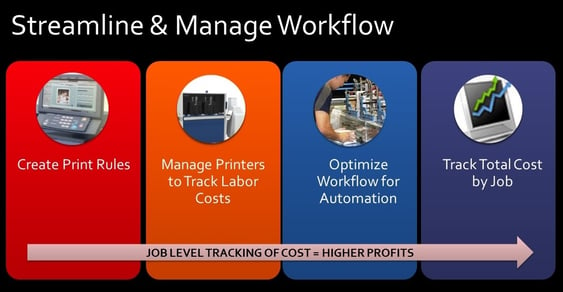Printers operating without a MIS system are flying blind
It is easy to tell if a print operation is making money by looking at profit and loss reports. Not so simple is finding the information management needs to make decisions such as determining how much work they can add before purchasing new equipment or when to hire more people. And recognizing the point to adjust pricing for individual jobs or accounts is nearly impossible without a system to capture job level data and generate cost analysis reports.
In many shops, job cost data from the production floor is randomly collected and rarely reviewed. Making the task even harder, many shops use separate, unconnected processes to handle estimates, order entry, job scheduling, postage deposits, time tracking, inventory, and billing. Employees manually copy information generated by one software system into another, leading to errors and omissions. Real time data is unavailable, rendering informed daily production adjustments impossible.
In environments where managers cannot compare job-level costs to budgets or estimates, changing conditions or inefficiencies can make it possible to unknowingly lose money on jobs–and do it repetitively.
Incidents during a workday can increase costs or cause printers to under bill their customers. A cushion built into the pricing may cover an occasional operational problem, but chronic issues on repetitive jobs can eat away at profitability. Unless printers have a workflow and MIS system that captures job level costs, they may never be aware of revenue and profit loss by job and account.

Here are common scenarios that can stealthily decrease net revenue:
- A service provider quoted a customer job assuming 98% of the mail would be machine-inserted. Later, customer format changes increased page counts, causing a larger portion of the job to exceed the letter-folding capacity of the machines. Inserter operators walk portions of the job over to the handwork crew for manual inserting into flats. Excess labor cost for hand insertion is not tracked.
- A change in customer-supplied files is causing operators to slow the production equipment. Labor for this part of the document production has increased to 150% of the budgeted amount but lack of tracking means the account team doesn’t know.
- Estimators use an Excel spreadsheet that has no intelligence. When account representatives fail to include a service on the estimate, or the shop adds services after quoting the job, the account is under billed.
- An estimator computed a customer’s postage charges based on 5-digit presort levels, but declining volume has resulted in most of the mail qualifying at higher, 3-digit rates. If the shop never adjusts the calculation for billing, they have reduced their profit margin on postage.
- Sometimes jobs come in late and miss the deadline for transporting mail to the presort vendor. Employees meter mail pieces at full rate and deliver the mail to the Post Office, but never notify the front office. The shop fails to bill for the excess labor and postage.
- A warehouse staffer finds a job jacket from six months ago hiding behind a some new inventory items. The billing department never billed the customer. It would embarrass the shop to invoice the customer now, so they write the job off as a loss. With insufficient checks and balances, such events could repeat.
Is your workflow working to drive profits?
Commercial software solutions and Management information systems (MIS) can help shops connect front office operations with production floor labor cost and statistics. Application programming interfaces and industry standards like JDF or XML make it possible to collect data from the variety of systems installed in most shops. MIS systems can streamline the workflow and collect all the relevant data in a single database with hand scanners for manual steps in the process. From there, printers can run reports that will help them see where to adjust pricing or be able to spot correctable workflow inefficiencies.
These tools may also include rules administration functionality that prevent costly quoting mistakes or issue alerts when something isn’t going as planned. Printing companies who operate without an MIS system are flying blind. As jobs become more complex featuring variable data, personalization, and multi-channel distribution, accurate and accessible job cost information becomes even more critical in a digital world. Is your workflow working to drive profits?

